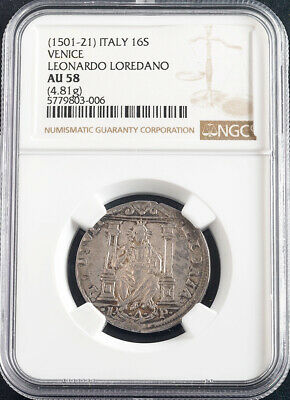-40%
1501, Doges of Venice, Leonardo Loredano. Rare Silver 16 Soldi Coin. NGC AU-58!
$ 255.01
- Description
- Size Guide
Description
CoinWorldTV1501, Doges of Venice, Leonardo Loredano. Rare Silver 16 Soldi Coin. NGC AU-58!
Denomination: 16 Soldi
Mint Period: 1501-1521
Reference: Paolucci p. 55, N. 5. Gamberini 247.
R1!
Condition:
Certified and graded by NGC as AU-58!
Diameter: 27mm
Weight: 4.81gm
Obverse:
The Doge kneeling before St. Mark who entrusts him the banner of Venice.
Legend: LEONAR L AVRED DVX S M VENET
Reverse:
Christ enthroned facing.
Legend: . GLORIA . TIBI . SOLI .
Exergue: . I . . ^ . . P .
Authenticity unconditionally guaranteed.
Bid with confidence!
Leonardo Loredan
or
Loredano
(16 November 1436 – 22 June 1521) of the Loredan family was the 75th doge of the Venetian Republic from 1501 until his death. His dogeship was one of the most important in the history of Venice.
After having studied literature, Leonardo Loredan commenced his political ascent at the age of nineteen when he became a lawyer in the “Giudici di Petizion” - magistracy concerned mainly with financial scandals and bankruptcies. A few years later, Leonardo sat on the “Collegio dei Savi” where he was responsible for assessing and evaluating foreign policy matters prior to their examination in Senate. Shortly after, Leonardo became the “Podestà” in the city of Padua – the Venetian equivalent of a governor ruling in the cities belonging to the Republic. In 1492, Leonardo Loredan was elected as the Procurator of San Mark's, a prestigious position that helped the future doge gain important political influence.
Loredan's wife was Giustina Giustiniani (d. 1500). Some historians claim his election as Doge in October 1501 was not entirely due to his talent as a politician but rather because his wife came from a very influential family.
At the time of his accession to the dogeship, Venice was engaged in the second Ottoman–Venetian War, which started in 1499. Loredan had lost his cousin Andrea, a naval officer in the disastrous Battle of Zonchio, and the war had proceeded badly on land too, with the Venetians losing considerable territory. This included the strategic city of Modon, which was the site of a bloody battle involving hand-to-hand combat, followed by the beheading of hundreds of Venetians following the Turkish victory. The war took a heavy toll on the Venetian economy and in 1502–1503 Loredan agreed a peace treaty with the Turks. He was helped in the negotiations by Andrea Gritti, a Venetian who had been conducting trade in Constantinople and would later become doge of Venice himself. Venice paid a high price for this treaty including loss of land and a requirement to pay an annual tribute to the Turks.
Upon the death of Pope Alexander VI in 1503, Venice occupied several territories in the northern Papal States. When Julius II was elected as Alexander's eventual successor, the Venetians expected their seizure of papal territory to be tacitly accepted, as Julius had been nicknamed
Il Veneziano
for his pro-Venetian sympathies. But instead the new Pope excommunicated the Republic and demanded the land be returned. The Republic of Venice, although willing to acknowledge Papal sovereignty over these port cities along the Adriatic coast and willing to pay Julius II an annual tribute, refused to surrender the cities themselves. In 1508, Julius formed an alliance called the League of Cambrai, uniting the Papal States with France, the Holy Roman Empire and several other Christian states.
The Doge's problems did not end in Europe. In 1509, the Battle of Diu took place, in India, where the Portuguese fleet defeated an Ottoman and Mameluk fleet, which had been transferred from the Mediterranean Sea to the Red Sea with Venetian help. The defeat marked the end of the profitable Spice trade, which was bought by Venetians from the Mameluks in Egypt and in turn monopolised its sale in Europe, reaping great revenues from it.
After losing to the league's forces at the Battle of Agnadello, Venice found its holdings in Italy shrinking drastically. Soon Padua, Venice's most strategically vital
Terraferma
holding, had fallen, and Venice itself was threatened. Loredan united the population, calling for sacrifice and total mobilisation. Padua was retaken, though Venice was still forced to accept a reluctant peace, following which it joined the Pope as only a junior ally in his new war against the French. The alliance was on the verge of victory, but a dispute arose over territory. Emperor Maximilian refused to surrender any Imperial territory, which in his eyes included most of the Veneto, to the Republic; to this end, he signed an agreement with the Pope to exclude Venice entirely from the final partition. When the Republic objected, Julius threatened to reform the League of Cambrai. In response, Venice turned to Louis; on 23 March 1513, a treaty pledging to divide all of northern Italy between France and the Republic was signed at Blois. Under this alliance with the French King Louis XII, the Venetians achieved a decisive victory over the Papal states, and were able to secure back all the territories they had lost. In addition, the Papacy was forced to repay many outstanding debts to the Loredan family totaling approximately 500,000 Ducats, an enormous sum of money.
Giovanni Bellini's portrait of Loredan is notable for being one of the first frontal portraits of a reigning doge; throughout the Middle Ages, mortal men had been portrayed in profile, while the frontal view had been reserved for more sacred subjects. Bellini's portrait was painted in 1501–02, and hangs in the National Gallery, London.
Over two centuries later, when Pompeo Batoni was given a detailed programme for his large
Triumph of Venice
(1737) by the Odescalchi cardinal who commissioned it, Loredan was chosen to represent the office of Doge, standing amid a group of allegorical personifications.
Only 1$ shipping for each additional item purchased!












